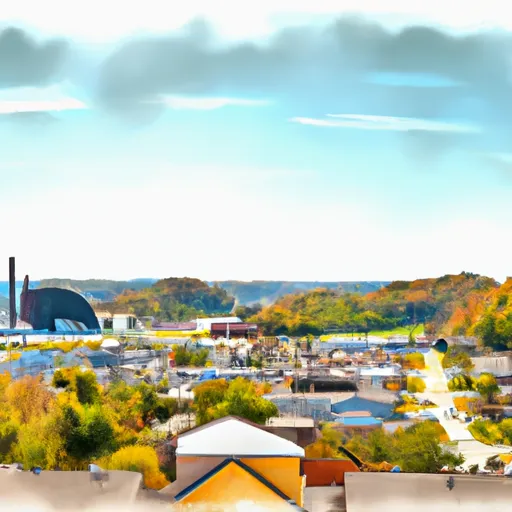-
 Snoflo Premium
Snoflo Premium
Get unlimited access to all our content
With no Ad interruptions! - Start Your Free Trial Login with existing account
Raven
Eden Index
Climate
8.2
•
Recreation
3.4
•
Community
•
Safeguard
4.5/10

Raven, Kentucky is a small town located in Pike County in the eastern part of the state. The climate in Raven is characterized by mild summers and cool winters, with average temperatures ranging from the mid-80s°F (29°C) in July to the mid-30s°F (1-3°C) in January. Precipitation is fairly evenly distributed throughout the year, with an annual average of around 45 inches (114 cm), providing ample water resources for the region.
Hydrologically, Raven is nestled in the Appalachian region, which is known for its abundant streams and rivers. The town is surrounded by several water bodies, including the Russell Fork River, which offers excellent opportunities for fishing, kayaking, and whitewater rafting. Additionally, the nearby Bear Branch Lake provides a serene setting for boating, swimming, and picnicking.
Outdoor enthusiasts will find numerous recreational opportunities in Raven. The town is located near the Breaks Interstate Park, known as the "Grand Canyon of the South," offering breathtaking views, hiking trails, and camping facilities. The surrounding mountains and forests also provide opportunities for hunting, hiking, and wildlife observation. Overall, Raven, Kentucky, is a haven for those seeking outdoor adventures and a chance to immerse themselves in the beauty of nature.
What is the Eden Index?
The Snoflo Eden Index serves as a comprehensive rating system for regions, evaluating their desirability through a holistic assessment of climate health, outdoor recreation opportunities, and natural disaster risk, acknowledging the profound impact of these factors on livability and well-being.
Climate Health Indicator (CHI): 8.2
Raven receives approximately
1151mm of rain per year,
with humidity levels near 81%
and air temperatures averaging around
13°C.
Raven has a plant hardyness factor of
6, meaning
plants and agriculture in this region thrive during a short period during spring and early summer. Most
plants will die off during the colder winter months.
By considering the ideal temperature range, reliable water supplies, clean air, and stable seasonal rain or snowpacks, the Climate Health Indicator (CHI) underscores the significance of a healthy climate as the foundation for quality living.
A healthy climate is paramount for ensuring a high quality of life and livability in a region, fostering both physical well-being and environmental harmony. This can be characterized by ideal temperatures, reliable access to water supplies, clean air, and consistent seasonal rain or snowpacks.
Weather Forecast
Streamflow Conditions
Big Sandy
Area Rivers
Big Sandy
Snowpack Depths
Big Sandy
Reservoir Storage Capacity
Big Sandy
Groundwater Levels
Recreational Opportunity Index (ROI): 3.4
The Recreational Opportunity Index (ROI) recognizes the value of outdoor recreational options, such as parks, hiking trails, camping sites, and fishing spots, while acknowledging that climate plays a pivotal role in ensuring the comfort and consistency of these experiences.
Access to outdoor recreational opportunities, encompassing activities such as parks, hiking, camping, and fishing, is crucial for overall well-being, and the climate plays a pivotal role in enabling and enhancing these experiences, ensuring that individuals can engage in nature-based activities comfortably and consistently.
Camping Areas
| Campground | Campsites | Reservations | Toilets | Showers | Elevation |
|---|---|---|---|---|---|
| Kinser Park | None | 1,314 ft | |||
| Cataloochee - Great Smoky Mountains | 27 | 2,652 ft | |||
| Carr Creek State Park | 40 | 1,093 ft | |||
| Paint Creek | 21 | 1,750 ft | |||
| Natural Tunnel State Park | None | 1,703 ft | |||
| Rocky Bluff | 30 | 1,753 ft | |||
| Old Forge | 15 | 2,154 ft | |||
| Cane Patch | 34 | 1,672 ft | |||
| Portal 31 RV Park | 20 | 1,841 ft | |||
| Houston Valley | None | 1,843 ft |
Nearby Ski Areas
Catastrophe Safeguard Index (CSI):
The Catastrophe Safeguard Index (CSI) recognizes that natural disaster risk, encompassing floods, fires, hurricanes, and tornadoes, can drastically affect safety and the overall appeal of an area.
The level of natural disaster risk in a region significantly affects safety and the overall livability, with climate change amplifying these risks by potentially increasing the frequency and intensity of events like floods, fires, hurricanes, and tornadoes, thereby posing substantial challenges to community resilience and well-being.
Community Resilience Indicator (CRI):
The Community Resilience Indicator (CRI) recognizes that education, healthcare, and socioeconomics are crucial to the well-being of a region. The CRI acknowledges the profound impact of these elements on residents' overall quality of life. By evaluating educational resources, healthcare accessibility, and economic inclusivity, the index captures the essential aspects that contribute to a thriving community, fostering resident satisfaction, equity, and social cohesion.

